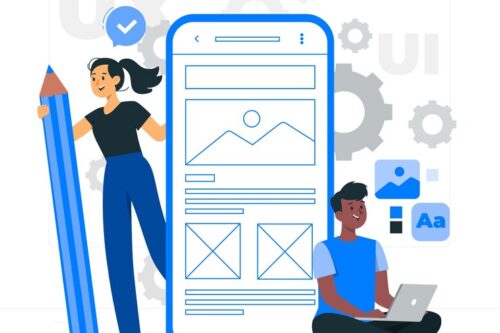In the world of web and app development, User Experience (UX) design has become a critical differentiator. A platform that’s intuitive and user-friendly can drive higher engagement, improve satisfaction, and boost conversion rates. But what exactly does it take to create a great UX? In this blog post, we’ll take a closer look at a real-life case study in UX design, explore the design process step-by-step, and show how making thoughtful, user-centered design decisions can drastically improve the outcome of a digital product.
Understanding the Importance of UX Design
Before diving into the case study, it’s important to understand what UX design entails. At its core, UX design is about making sure a product or service provides a meaningful and relevant experience to the user. The goal is to ensure users can easily and efficiently achieve their objectives—whether that’s completing a purchase, applying for a job, or, in this case, navigating an online platform.
Good UX design is not just about creating visually appealing websites or apps. It’s about designing systems that are intuitive, meet user needs, and minimize friction. If users feel frustrated or lost while navigating your platform, they’re likely to abandon it and turn to a competitor.
Now, let’s explore how one company applied UX design principles to improve their platform through a real-world case study.
Case Study: Revamping the Application Process for a Study Abroad Platform
Background: The Problem
The company in question is a study abroad platform that connects students with educational opportunities overseas. While the platform provided a valuable service, user feedback indicated that many prospective students found the application process to be cumbersome and confusing. The forms were long, the navigation was cluttered, and students often felt overwhelmed by the sheer amount of information they had to process.
The goal of the redesign was simple: make the application process smoother, faster, and more user-friendly.
Step 1: Research and Understanding the User
The first step in any UX design process is understanding who the users are and what their pain points are. For this project, the team conducted a series of user interviews and surveys with current and potential students. They also analyzed site analytics to see where users were dropping off during the application process. This research helped the team uncover key insights about the students’ experiences and frustrations.
Here are some of the critical findings:
- Complex Forms: Users struggled with lengthy forms that didn’t offer real-time validation or feedback.
- Overwhelming Choices: The platform displayed too many options at once, making it hard for students to find relevant programs or opportunities.
- Confusing Layout: The navigation system was not intuitive, leading to users getting lost or confused about where to go next.
Step 2: Identifying User Personas
Next, the team created user personas based on the research findings. These personas represented different types of students using the platform, each with unique goals and challenges.
- Persona 1: Sarah (A high school senior looking to study abroad)
- Persona 2: John (A college student considering an exchange program)
- Persona 3: Emily (A parent of a potential student, looking for information on safety and costs)
By understanding these personas, the design team could better tailor the user experience to meet the specific needs of each group, ensuring that the platform would be both engaging and functional for a wide range of users.
Step 3: Redesigning the Platform
With a clear understanding of the users’ needs, the design team began the redesign process. Here are some of the key changes made to improve the user experience:
Simplifying the Application Form
One of the most significant pain points was the lengthy and complicated application form. The team reduced the number of fields, breaking the form into smaller, more digestible sections. They added real-time validation to ensure that users knew when they’d made an error before submitting the form, rather than getting stuck in the middle of the application process.
Additionally, the form was mobile-optimized, recognizing that many users would be completing their applications on their smartphones or tablets.
Improving Navigation and Information Architecture
To solve the issue of overwhelming choices, the team streamlined the platform’s navigation. They created a clearer, category-based structure that allowed users to quickly find the information they needed. The homepage was reworked with minimal distractions and a focus on key actions, like applying for programs or accessing support.
Personalized Recommendations and Dashboards
The new platform incorporated personalized recommendations based on the user’s interests and previous interactions. For example, a student who had viewed several engineering programs would see similar options displayed on their dashboard. This helped students feel like the platform was tailored to their needs and reduced the time spent searching for programs.
Aesthetic and Visual Design Tweaks
The platform also underwent a visual redesign to improve its overall appeal and functionality. The color scheme was simplified, and fonts were chosen for better readability. The new design emphasized visual hierarchy, making it easy for users to focus on what mattered most without being overwhelmed by too much information at once.
Step 4: Usability Testing and Iteration
After completing the initial redesign, the team conducted usability testing with real users to identify any remaining issues. They invited users to complete tasks on the platform while observing their interactions and collecting feedback.
Through this iterative process, the team made further refinements. For example, they adjusted the language used in some forms to make instructions clearer, and simplified certain design elements based on user preferences. A/B testing was also conducted to evaluate different versions of specific features and determine which provided the best user experience.
Key Usability Testing Findings:
- Students appreciated the shortened application forms but suggested adding more contextual help for certain fields.
- The personalized dashboard was a hit, with users commenting that it made the process feel more tailored to their needs.
- The navigation improvements reduced frustration, and students were able to find programs much more quickly.
Step 5: Launch and Results
After refining the design based on feedback, the new platform was launched. The impact of the redesign was measured using several key performance indicators (KPIs), including:
- Increased Conversion Rates: The streamlined application process led to a 20% increase in completed applications.
- Improved Engagement: User engagement metrics (such as time spent on the platform and pages viewed per session) improved by 25%.
- Reduced Bounce Rates: The revamped navigation and personalized features contributed to a 15% decrease in bounce rates, meaning users were more likely to stay on the platform and explore different programs.
Conclusion: The Power of UX Design
This case study shows how thoughtful, user-centered design can have a measurable impact on a platform’s success. By focusing on the needs of the user and continuously iterating based on feedback, the design team was able to create a more engaging, efficient, and enjoyable experience for students applying to study abroad.
In the fast-paced digital world, UX design isn’t just a nice-to-have—it’s a must-have. Whether you’re redesigning a study abroad platform, an e-commerce site, or any other type of digital product, investing in UX design can pay off in terms of increased user satisfaction, higher conversion rates, and better overall engagement.
If you’re considering a redesign for your platform, remember: understanding your users and aligning your design with their needs is the key to creating a successful and user-friendly experience.
FAQs
- What is UX design, and why is it important?
- UX design focuses on improving user satisfaction by making products easier and more enjoyable to use. In the case of a study abroad platform, good UX helps users complete tasks efficiently, reducing friction and improving engagement.
- How can UX design improve conversion rates?
- By making the process smoother and more intuitive, users are less likely to abandon tasks like filling out forms or applying for programs, leading to higher conversion rates.
- What role does user feedback play in UX design?
- User feedback is essential in UX design as it helps identify pain points and areas for improvement. Iterating based on real user feedback ensures that the design meets user expectations.
- What are some common mistakes in UX design?
- Common mistakes include cluttered interfaces, poor navigation, and a lack of personalization. These can frustrate users and lead to high bounce rates and low engagement.
- How can mobile UX be optimized for better user experience?
- Mobile UX can be optimized by simplifying layouts, improving load times, and ensuring that all features are easily accessible on smaller screens.

